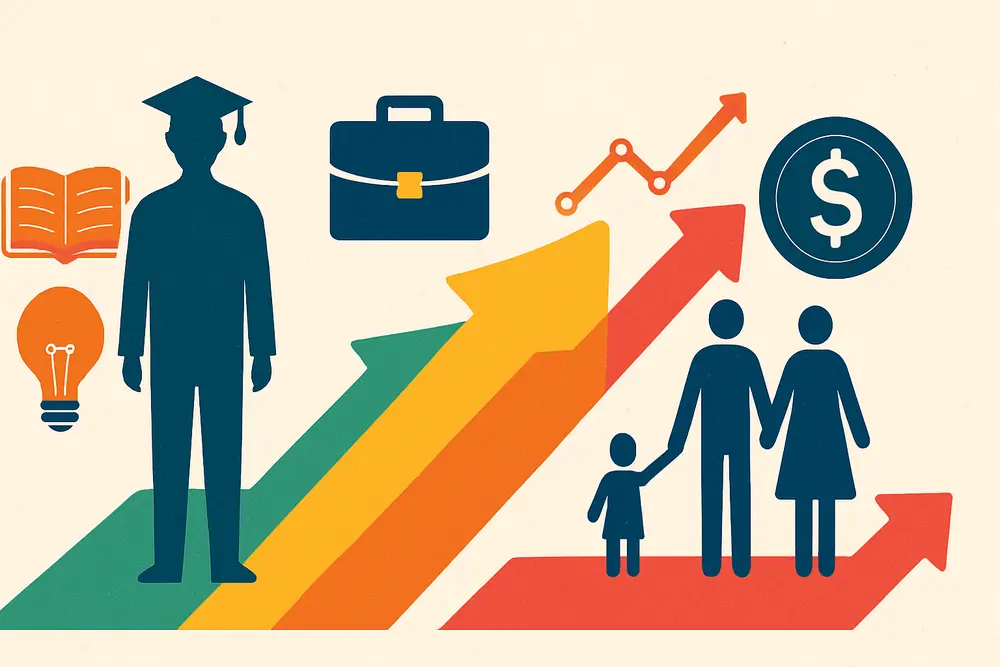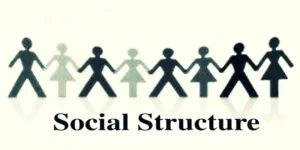Are We Moving Up? What Intergenerational Mobility Trends Say About Your Future?
Intergenerational mobility refers to the degree to which individuals’ social or economic status differs from that of their parents, reflecting changes in income, education, or occupation across generations.
Intergenerational mobility trends reveal how family background influences your opportunities, income potential, and social status across generations.
Let’s explore comprehensive insights into intergenerational mobility trends and their profound impact on modern society.
Delve into how family background, education, policy, technology, and geography shape economic opportunity and social justice across generations.
Discover actionable strategies to enhance upward mobility—including equitable education reforms, targeted economic policies, and digital inclusion initiatives—and learn how data-driven solutions can build a more equitable future for individuals from all backgrounds and community-driven programs, today.

How Intergenerational Mobility Trends Shape Social Justice and Economic Opportunity
Have you ever wondered why some families seem to climb the socioeconomic ladder from one generation to the next while others stay stuck in the same place? That’s the essence of intergenerational mobility—how economic status, education, and opportunities transfer from parents to children.
Intergenerational mobility trends reveal how family background dictates economic outcomes and equity.
High mobility fosters fairness, empowering individuals irrespective of birth circumstances. Conversely, low mobility entrenches inequality, undermines social justice, and limits opportunities.
In recent decades, researchers have been uncovering fascinating trends that shed light on the evolving shape of our modern society.
From widening income gaps in some regions to improvements in education access in others, intergenerational mobility isn’t just an academic term—it reflects real-world stories of aspiration, hardship, and change.
In our increasingly globalized and digital world, factors like technology, policy decisions, and cultural shifts can dramatically alter mobility pathways.
For example, access to quality schooling and mentorship programs can create ladders for upward movement, while stagnant wages and unequal resource distribution can build invisible ceilings.
If we explore these trends, we can better understand why some communities flourish and why others struggle to break free from cycles of disadvantage.
In this article, we will discuss intergenerational mobility trends and their impact on modern society. So read it to the end!
What is intergenerational mobility and why does it matter today?
Intergenerational mobility measures the degree to which a person’s economic and social status differs from that of their parents.
In simple terms, it asks: are children doing better, worse, or the same as their parents did at a similar age? This concept matters because it reflects the fairness and openness of a society.
High mobility suggests that hard work and talent can lead to success regardless of one’s starting point, while low mobility implies that family background heavily dictates life outcomes.
Today, mobility matters more than ever as economies evolve rapidly. Automation, gig economies, and global competition are reshaping job markets.
If mobility stalls, rising inequality can breed frustration, erode trust in institutions, and hamper social cohesion. Conversely, upward mobility fuels hope, encourages investment in education, and drives innovation.
By understanding intergenerational mobility, policymakers can craft targeted interventions—like expanding early childhood education or reforming tax policy—to ensure that the next generation has real opportunities to thrive. After all, a society where dreams aren’t limited by birthright benefits everyone.
How have intergenerational mobility trends evolved in recent decades?
Over the past few decades, intergenerational mobility has shown mixed patterns across countries and regions.
In many high-income nations, mobility rates plateaued or even dipped slightly between the 1980s and 2000s.
Stagnant wages for middle- and lower-income workers, combined with skyrocketing education and housing costs, have made it harder for young adults to surpass their parents’ status.
Yet, some countries like Canada and the Nordic nations have maintained relatively higher mobility due to robust social safety nets and accessible education systems.
Emerging economies paint another picture: rapid economic growth lifted millions out of poverty, boosting mobility for broad swaths of the population.
However, rising inequality in these regions can threaten long-term gains if left unchecked.
Meanwhile, digital transformation has created new pathways for entrepreneurship and remote work, potentially enhancing mobility—if digital literacy and infrastructure keep pace.
Understanding these evolving trends helps us pinpoint best practices and areas needing reform, so we can build societies where anyone can write their own success story, regardless of the decade they were born in.
What role does education play in shaping intergenerational mobility?
Education often serves as the single most powerful driver of upward mobility. Quality schooling equips young people with skills, credentials, and networks that unlock higher-paying jobs and career advancement.
When education systems are equitable—offering strong public schools, scholarships, and vocational training—students from diverse backgrounds can compete on a level playing field.
Conversely, unequal access to quality education can cement privilege, keeping children of affluent families well ahead while others lag behind.
Beyond formal degrees, lifelong learning and skill reskilling are increasingly vital in today’s fast-paced job market.
Adults who embrace continuous learning—through online courses, certifications, or community college—can pivot careers and seize new opportunities.
Governments and employers that invest in affordable training programs help sustain mobility by bridging skill gaps.
Ultimately, education is widely recognized as a powerful tool for increasing social mobility. When education is treated as a public good rather than a privilege, societies foster resilience, innovation, and genuine intergenerational progress.
How do economic policies influence social mobility?
Economic policies—from tax structures to minimum wage laws—play a pivotal role in shaping mobility.
Progressive tax systems can redistribute wealth, fund social programs, and level the playing field. For instance, tax credits for low-income families boost disposable income, giving children access to better nutrition, healthcare, and schooling.
Conversely, regressive tax policies can exacerbate inequality, trapping families in cycles of poverty.
Labor market regulations also matter. A robust minimum wage, collective bargaining rights, and unemployment insurance provide stability for vulnerable workers, enabling them to invest in their children’s futures.
On the flip side, overly lax labor protections can lead to precarious jobs with little room for advancement. Moreover, targeted investments—like infrastructure projects in underserved regions—can create local employment and stimulate regional mobility.
By aligning economic policies with mobility goals, governments can nurture an environment where hard work and talent truly pay off.
Read Here: The Impact of Government Policies on Income Inequality
In what ways does family background impact a child’s mobility prospects?
Family background shapes the resources, support, and expectations a child experiences from the very start.
Wealthy families can afford enriched environments—good schools, extracurricular activities, tutors—that boost academic and social skills. They also pass down social networks that open doors to internships, mentorships, and job opportunities.
Psychological factors like parental encouragement and exposure to success mindsets further reinforce positive outcomes.
Yet, not all advantages are financial. Strong family cohesion, emotional support, and resilience-building can empower children to overcome adversity.
Communities with tight-knit networks and cultural capital often foster norms of collective uplift, where neighbors mentor youth and share resources.
Acknowledging the multifaceted nature of family influence highlights why policy solutions must go beyond cash transfers—focusing also on community development, parenting programs, and affordable childcare so that every child has a supportive launchpad into adulthood.
How does geographic location affect intergenerational mobility?
Where you grow up can significantly influence your life trajectory. Regions with thriving economies, good schools, and safe neighborhoods offer clear pathways to success.
Urban centers often provide diverse job markets and cultural institutions that enrich learning and social capital.
In contrast, rural areas or post-industrial towns with declining industries can leave residents with limited prospects, making upward mobility an uphill battle.
Public investments in transportation, broadband internet, and regional universities can bridge these divides by connecting isolated areas to broader opportunity networks.
Moreover, remote work trends hold promise for distributing economic benefits more evenly, allowing talented individuals in underdeveloped regions to tap into global markets.
By addressing geographic disparities, policymakers can unlock latent potential in communities that have long been sidelined, driving more inclusive and balanced mobility outcomes.
What impact does technology have on modern mobility trends?
Technology acts as both a ladder and a barrier in today’s mobility story. On one hand, digital platforms democratize access to education and entrepreneurship—massive open online courses (MOOCs), e‑commerce, and freelancing marketplaces let ambitious individuals transcend traditional constraints.
Tech-driven industries create high-skilled job clusters that reward innovation and foster new middle classes.
On the other hand, automation threatens routine jobs, disproportionately affecting workers without advanced skills.
The digital divide—differences in internet access and tech literacy—can widen existing inequalities if left unaddressed. Bridging that divide requires investments in broadband infrastructure, digital training programs, and affordable devices.
When technology policy focuses on inclusive access and upskilling, it can supercharge mobility; if neglected, it risks deepening divides between the tech-savvy “winners” and the displaced “losers” of automation.
How do cultural attitudes shape perceptions of mobility?
Cultural beliefs about work ethic, family roles, and success narratives deeply influence mobility.
In societies that celebrate entrepreneurial risk-taking and view failure as a learning step, individuals may feel freer to innovate and pursue non‑traditional paths.
Conversely, cultures that stigmatize job hopping or penalize nonconformity can stifle mobility by discouraging experimentation.
Narratives passed through media, literature, and community traditions also matter. Stories of “self‑made” icons can inspire, but if they gloss over systemic barriers, they risk promoting myths of meritocracy that ignore structural challenges.
Recognizing the power of cultural framing helps us craft more honest dialogues—one that balances celebrating individual achievements with acknowledging the social systems that enable or inhibit success.
What strategies can boost intergenerational mobility for future generations?
To enhance intergenerational mobility for future generations, a multifaceted strategy is essential.
First, universal early childhood education programs lay a strong cognitive and social foundation.
Second, reforms that make higher education and vocational training affordable can prevent talent loss.
Third, targeted tax incentives and child allowances can alleviate economic strains on low-income families.
Fourth, investments in rural and underserved urban infrastructure—like public transit and broadband—open up new markets and job opportunities.
Fifth, lifelong learning initiatives and apprenticeship programs help adults adapt to changing labor demands.
Collaboration between governments, private sector, and nonprofits is key. Mentorship networks, community centers, and employer‑led training can complement public efforts, creating a safety net that guides individuals at every life stage.
If societies integrate these strategies into coherent policy packages, they can ensure that the promise of upward mobility remains alive for generations to come.
Read Here: The Impact of Income Inequality on Social Mobility
Conclusion
Intergenerational mobility trends offer a compelling window into the health and fairness of our modern society. They capture the dynamic interplay of education, policy, family, geography, technology, and culture—each weaving a thread through the tapestry of opportunity.
While some regions enjoy robust pathways to advancement, others grapple with persistent barriers that trap families in cycles of disadvantage.
Recognizing these divergent experiences is the first step toward designing solutions that work for everyone, not just a fortunate few.
The conversation around mobility must move beyond abstract statistics to embrace the lived realities of individuals and communities. That means listening to families who have broken through ceilings, studying regions that have successfully revitalized their economies, and understanding the cultural mindsets that foster resilience and ambition.
Armed with these insights, stakeholders can craft policies—from universal early education and equitable taxation to digital inclusivity initiatives—that empower individuals from all backgrounds.
Ultimately, the goal is to create a society where birthright doesn’t dictate destiny. A future where talent, hard work, and creativity are the true currencies of success.
If we commit to data‑informed, equity‑driven strategies today, we can ensure that the next generation inherits not just stagnant status quos, but real prospects for upward mobility and shared prosperity.





